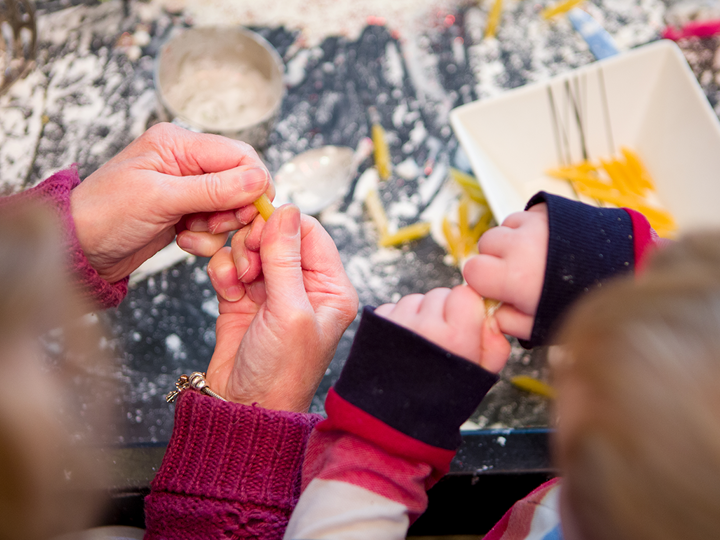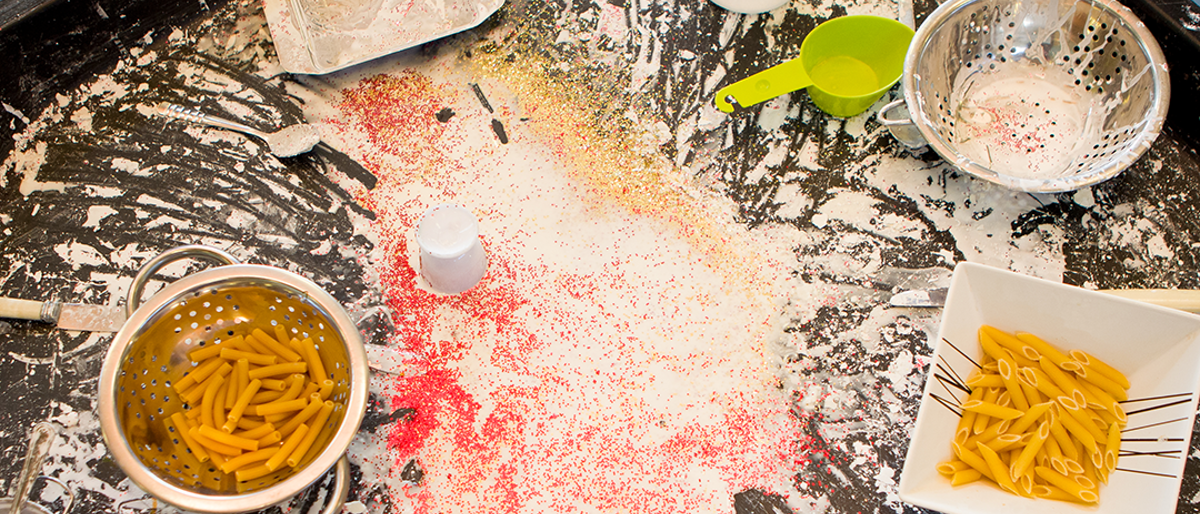Messy play
- 0-1 Years
- 1-5 Years
- 5-11 Years
- Child development and growing up

Messy play is also known as sensory play. It's a way of playing that uses your child's 5 senses (touch, taste, smell, sound and sight). Messy play lets your child explore lots of different materials, textures and objects. It will also help develop your child's creative and cognitive skills.
The importance of messy play
Messy play helps with your child’s development in lots of different ways. It can help:
Physical skills. Messy play encourages your child to play with smaller objects. They will be able to to feel, hold and mold objects and materials. This builds their coordination and hand skills, also known as fine motor skills.
Cognitive skills. It helps the development of important cognitive skills such as how your child thinks, learns, explores and solves problems.
Understanding their senses. As your child plays, they will be using a lot of their senses. The most used sense during messy play will be touch and sight. They can explore new textures and sensory experiences.
Social skills. Messy play can be a social group activity. They can also learn important skills like sharing and turn taking by playing with other children during messy play.
Imagination. It gives your child an opportunity to try new things and experiment in a safe environment.
Self-esteem and self-expression. It can help your child feel safe to experiment more as they play as they know there is no right or wrong way to play.
Messy play at home
Preparing for messy play
Some messy play activities are messier than others. Ways to prepare your environment, your child and yourself for messy play:
- Wear old clothes
- Try to keep hair tied back and out of you and your child’s face
- Set up in places that are easier to clean up such as outside, on the kitchen floor or in the bathtub
- Depending on the activity, put down newspaper or a plastic tablecloth to reduce the cleanup
- Depending on the activity, keep some towels and wipes nearby for clean-up.
Ideas for messy play at home
Sensory trays
Sensory trays (also known as sensory bins) are where you fill trays and boxes with different items that encourage your child to explore and play with the objects and use their imagination.
There are lots of ways you can make sensory trays for your child at home using everyday household items.
- Dry foods: rice, beans, lentils, popcorn kernels, dried pasta, seeds, coffee beans, flour, jelly beans, dried chickpeas and cereals like cheerios, shreddies, rolled oats and cornflakes.
- Wet foods: custard, yogurt, jelly, ice cubes, sweetcorn, baked beans, spaghetti hoops and letters, whipped cream, cornflower and water.
- Cooked foods: rice, pasta, porridge, chickpeas.
- Household materials: beads, buttons, cotton wool, compost, feathers, hay/straw, marbles, mud, sand, sawdust, shaving foam, stones and water.
- Seasonal items: Spring can use easter eggs, grasses, dried flowers and fresh flowers. Summer can use pebbles, sand, seaweed, shells, and water. Autumn can use acorns, fir cones, leaves, pumpkins and pumpkin seeds. Winter can use candy canes, snowflakes from paper, tinsel, and twigs.
You can theme the bins around things your child likes such as forest animals. You could get green lentils, blue stones to pretend to be water and have little cut outs or toys of animals.
Try to keep things like plastic cups, bowls, scoops, bottles and children’s tweezers for your child to use when they play with the bin.

Make your own colourful rice
You can also make your own colourful rice:
- Place dried rice into different small plastic food bags
- Add food colouring
- Shake well until the food colouring covers all the rice
- Place into containers to dry. You can use old food tubs like margarine tubs for this.
- Use once rice has dried
Ways to play with sensory trays
When you first introduce the sensory tray to your child, let your child explore and play with the tray without any comments or help from you. This lets them use their imagination to play in a way they want.
Once your child has had their first play, you can start to play alongside them. You could draw or write letters in the different textures. This can help your child understand shapes and letters and how to make them.
You can also play hide and seek with the items in the bin. You could hide the letters of their name in the bin and encourage them to find the letters. Once they’ve found all the letters they can then use them to spell their name out. Alternatively, you could hide pieces of a puzzle and build the puzzle as they find all the pieces.
If you don’t want to get messy in your home or you have a limited amount of space, visit your local children’s centre. Lots of children’s centres will have messy play activities.
